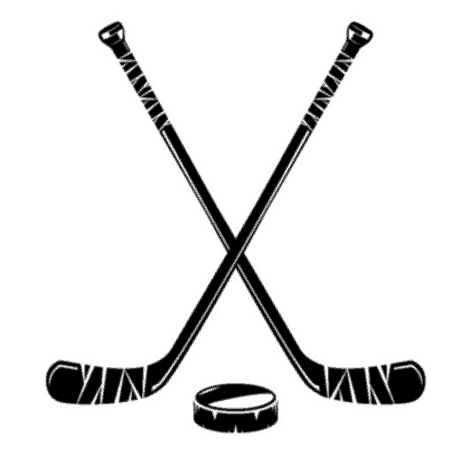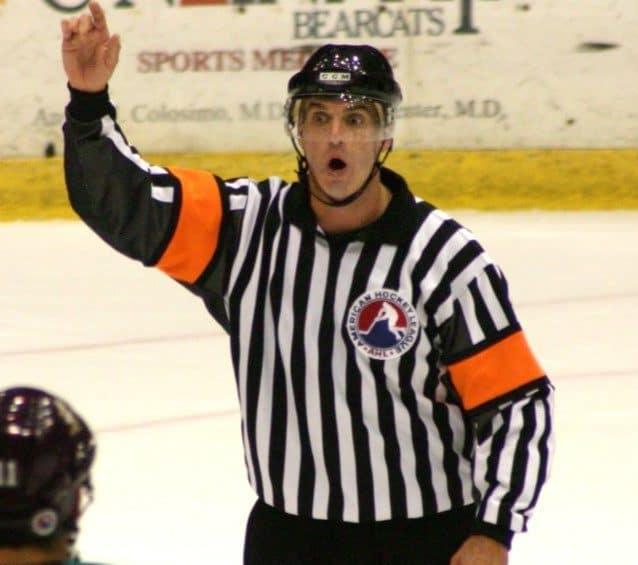Officials in all sports have distinct uniforms; common among them are black and white stripes. Why do hockey refs have orange bands?
Hockey refs have orange bands because it identifies them as a referee. The officials on the ice that do not have orange bands are linesmen. There are 2 linesmen and 2 referees on the ice at one time officiating the game. Both units have differing responsibilities during the game.
Like other sports, each type of official focuses on certain aspects of play. What responsibilities does each official play in governing the game?
What does a Hockey Referee do?
A hockey referee is in charge of calling penalties and goals. This might seem easy, but there is a reason the NHL deploys 4 officials per game. The 2 refs mirror each other up and down the ice, watching for the many infractions players could commit on each other, as well as the all-important goal. Ensuring the puck crosses completely across the goal line is their main role. The referee positioned by the goal signals a good goal or waves it off.
Referees and linesmen do have shared responsibilities throughout the game. For example, if there is a stick on the ice that was not picked up by a player or any shrapnel on the ice, the closest official will pick it up and return it to the correct bench. If it is a small piece of trash on the ice, they will put it in their pocket until the next stoppage in play.

Referees are seen as the senior officials on the ice. If there is a video review or a controversial play, you will see the ref skate in front of the penalties box, turn his mic on, and make the announcement to the fans. Whenever the coach has an issue or needs to talk, the referees do the talking. The only 2 officials that can start and stop gameplay are referees.
What does a Hockey Linesman do?
A hockey linesmen is primarily responsible for making calls around the blue line, hence the name linesmen. You will see them standing on the blue line to ensure the offensive players enter the zone after the puck does. If the players enter before the puck, the play is blown dead for an offsides call. The fun action for a linesmen is getting the opportunity to break up fights. They are the ones that are in between players and yelling at them to let go of each other. Yes, a linesmen getting punched or hit in the face does happen.
In regards to penalties, the linesman assists with infractions dealing with the game as a whole, not a specific player. For example, a delay of game penalty where the defensive chips the puck over the boards from their own defensive zone, is harder to see when a ref is looking directly at the player with the puck. When refs are not confident of the call, they will all huddle up and take guidance from all officials. Another example is a to many men on the ice penalty. This involves a large part of the ice, so they will assist in calling this penalty. Everyone is involved in a fight or skirmish.
Fighting- Linesmen or Referees?
The all famous play in hockey, fighting. There is a code to fighting, and the officials respect it. Sometimes refs and linesmen break up a fight and other times they let it play out. Although the linesmen are the ones that jump in and break it up, the referees do their job by observing the fight assessing penalties afterward. To avoid getting punched in the face, linesmen let players duke it out.
The two main situations of fights are treated differently. If the officials can break up a fight as it is evolving, they will. If they do not catch it in down, they will wait until after the players have wrestled themselves down to the ice. If players drop the gloves and start going after each, there is not much the linesmen can do besides get out of the way, but stay close enough to pull the players off each other once the right is over.
The other example is when there is a scuffle around the goal or up against the boards. This usually involved multiple players and starts with a face full of the opponent’s glove or a nice whack on the calve. The scuffle can turn into a full-fledge brawl with multiple players involved if it is not extinguished quickly. The officials try to get in between players before the situation escalates, but the players far outnumber the officiating crew.
Video Replay
Video replay is the hot topic in today’s sports. Many plays can be reviewed, and the number seems to be growing every year. With controversies happening every year in the playoffs, the NHL continually expands the possible plays that can be reviewed. The major plays that can go to a video review are goals that involved the puck crossing the line completely, a scoring play entering the zone in an offensive position, and 5 other goal-scoring situations. Every goal is reviewed in Toronto, where replay officials watch every single goal that is scored in real-time. Major hits are also reviewed in case a suspension or fine needs to be enforced.
The NHL started using instant replay in 1991. Few fans actually know it started that long ago. The use of video reviews has increased drastically over the past few years. It was not until 2003 that the pressure was released from refs on the rink making big-time calls, and allowing the replay officials to step in and assist in the call. All reviews now come from one spot, in Toronto, known as the War Room.
Video review in the NHL, more than any other sport, reviews plays after the game. If a ref misses how egregious a hit is in real time, that players time is coming. Although the team who’s player is probably injured is furious, the justice will not come until after the game, allowing the league to take a look and hand out a fine or suspension.
In 2015, the NHL started allowing coaches challenges, which gets instant replay officials involved. When challenges started, coaches were given one challenge to use per game, and if they lost the coach’s challenge, the timeout was stripped from the team. As this article is being written, the stakes have increased. If you challenge a call on the ice and do not win the challenge, it will cost you a 2-minute minor penalty. It gets better. If the coach is feeling good and wants to challenge another play after losing the first dispute, they are risking a four-minute double minor. There is no limit to how many times the can challenge; the risk is adding a two-minute penalty every time.
What do Refs Wear?
The official’s outfit is the same for linesmen and refs, except the orange (sometimes red) band around each bicep. They wear a helmet, black and white long sleeve shirt, black pants, skates, and a whistle. The helmet is the most important part of the uniform and must be selected carefully. All officials in today’s game wear visors to protect their eyes. As it is commonly known, refs and players alike used to not wear helmets. Depending on the league, there might be a slight alteration to the uniform or a sponsor, but this is the common uniform.
There are not specific skates that officials wear, just normal competitive skates do the job. All officials’ laces for their skate are white. There is nothing fancy about the uniform of a ref. Their pants are usually a little bag, which allows them to skate well. Many refs today have very loose padding inside their pants incase there is a fall or collision with a player during the game. Refs skate at fast speeds and stop quickly, so it is recommended that they have some padding. There will be a patch of the league they officiate on the top left side of their shirt, and their assigned number on the back.

